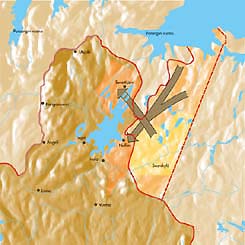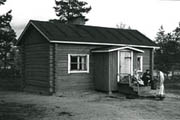| |
|
|
The Skolt Sámi Homeland
Returning north after evacuation
 |
|
Eventually, the Sámi of the Petsamo village settled permanently
in the Nellim area, the Sámi of the Paatsjoki village in Keväjärvi
and the Sámi of the Suonjel, or Suonikylä, village in
the Sevettijärvi-Näätämö area. The map opens
up larger when you click it. Map: Sámi Museum Siida |
After World War II - when the Skolt Sámi had returned north from
their evacuation destination Ostrobothnia - they lived temporarily in
new areas: some close to their former native lands in the vicinity of
the Luttojoki River, some in wartime barracks and dugouts in the neighborhood
of Lake Nangujärvi and Lake Tsarmijärvi, and some in the Lappish
houses that had survived the war in the roadless wilderness north of Lake
Inari, waiting for the decision on where to settle for good.
The Sámi from Petsamo got their first permanent homesteads in
the late 1940s. Through a law on the settlement of Skolt Sámi,
a "Skolt Sámi area" was defined; it was situated in the
eastern parts of the municipality of Inari, on state land. In this area,
settlement concentrated in the neighborhoods of Nellim, Keväjärvi,
and Sevettijärvi. The Sámi from the Petsamo Lapp village were
settled in the vicinity of Nellim, those of the Paatsjoki Lapp village
in Keväjärvi and on the Rautujoki River in Sevettijärvi,
and most of the Sámi from Suonikylä in the area of Sevettijärvi.
 |
| The state had 52 new houses, or
"Skolt homes", built in the Sevettijärvi area, 43 houses
in the region of Nellim and Pikku-Petsamo, and two in Hyljelahti Bay
north of the village of Inari. A Skolt Sámi home in Sevettijärvi
in the 1950s. Photo: National Board of Antiquities |
New villages with a number of services replaced the old homesteads, which
had been situated along the roads and destroyed in the last phase of the
war. This happened in Keväjärvi and Nellim. However, the road
to the Arctic Ocean, which ran through the villages, ended on the Soviet
border in Virtaniemi, and one could no longer cross the border and continue
the trip from there. In Sevettijärvi, a new Skolt Sámi settlement
rose, covering a 60-kilometer-long belt from Lake Nitsijärvi to Lake
Kirakkajärvi. At first, there was no road leading to this area, which
was hard to reach both by land and water.
|
|
